Abstract
We investigated the effects of isoproterenol on the pulmonary mechanics of eight healthy male subjects. We measured the flow-volume, pressure-volume, resistance-volume, and pressure-flow relationships of the lungs of our subjects in addition to the forced expiratory volume (FEV1). The results of this study confirm earlier observations that isoproterenol produces a considerable decrease in airway resistance but only small changes in maximum expiratory flow. Measurements of static pressure-volume curves showed that isoproterenol caused a temporary decrease in the elastic recoil pressure of the lungs. In five men there were mean falls in recoil pressure of 4.1 cm H2O at 85% total lung capacity (TLC), 2.6 cm H2O at 75% TLC, and 1.5 cm H2O at 50% TLC. We postulate that the reason for the relatively small increments in maximum expiratory flow after isoproterenol is primarily that the effects of airway dilatation are in large part negated by the reduction in lung recoil pressure, which results in a fall in the maximum effective driving force for expiratory air flow, and secondly that there is an increase in the compliance of the flow-limiting airways. These studies emphasize that tests of maximum flow and of airway resistance should not be regarded as invariably interchangeable in the assessment of airway reactions or mild disease of the airways.
Full text
PDF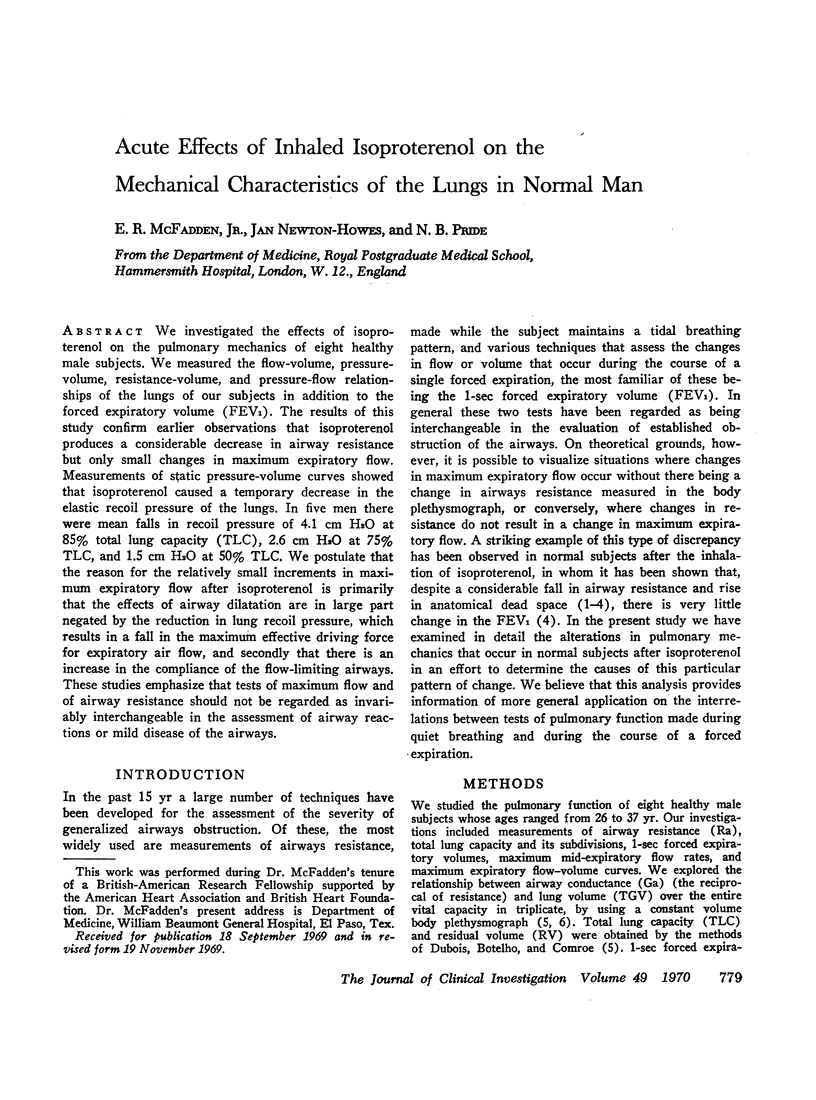
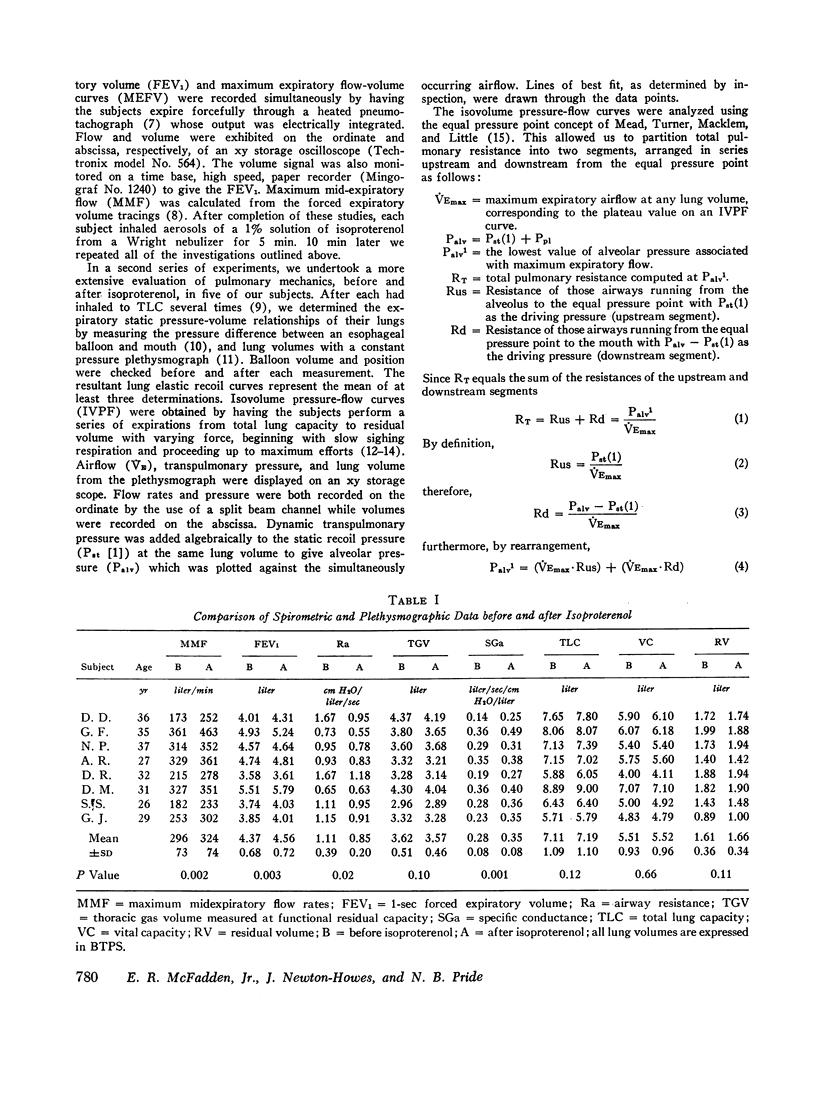
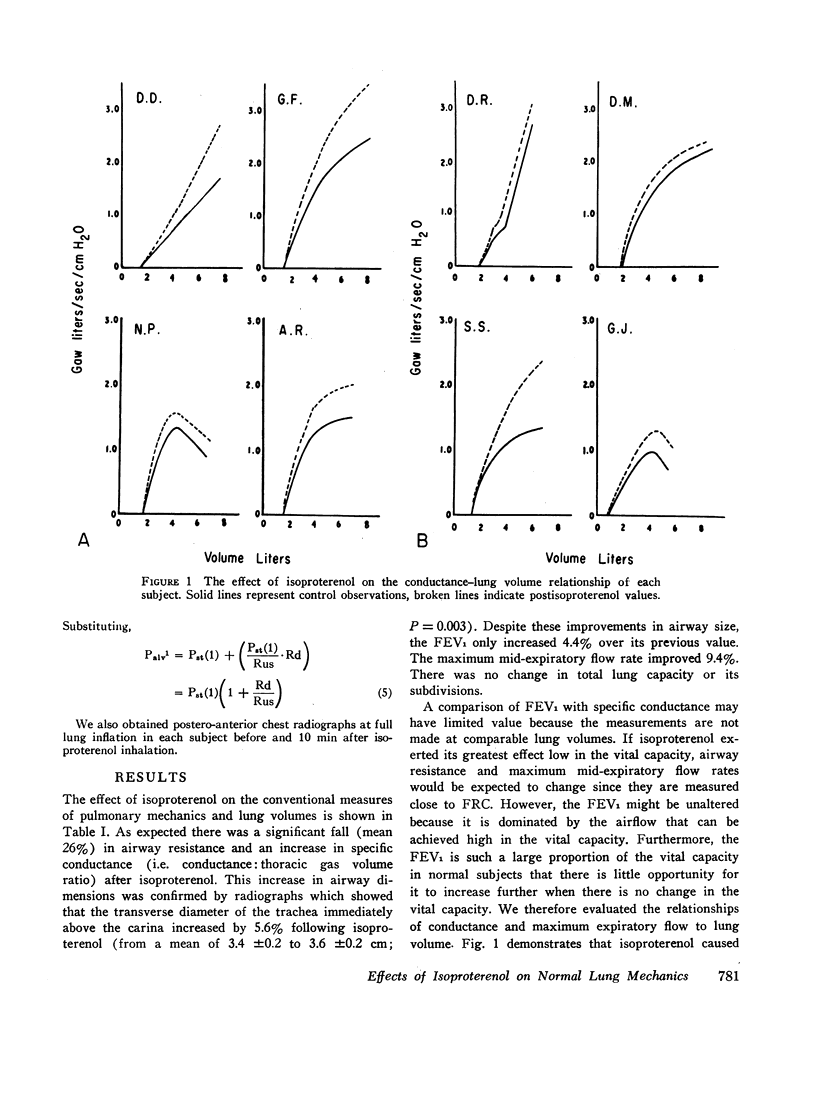
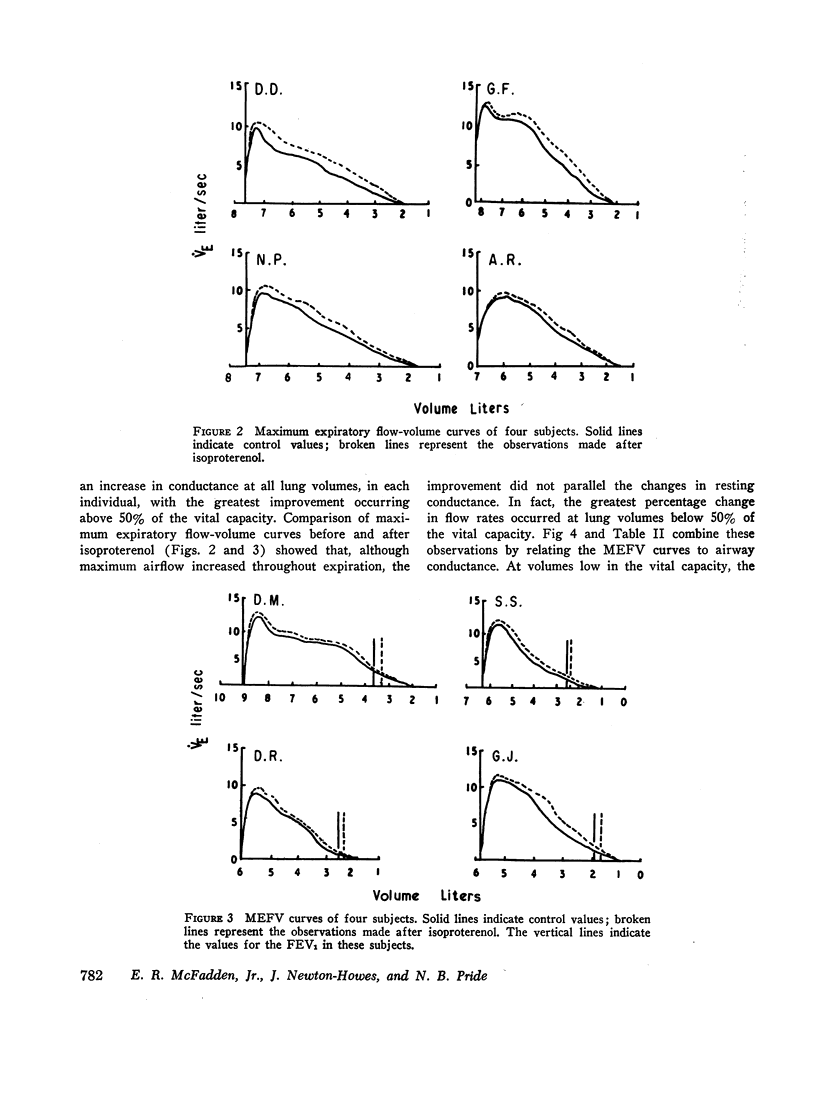
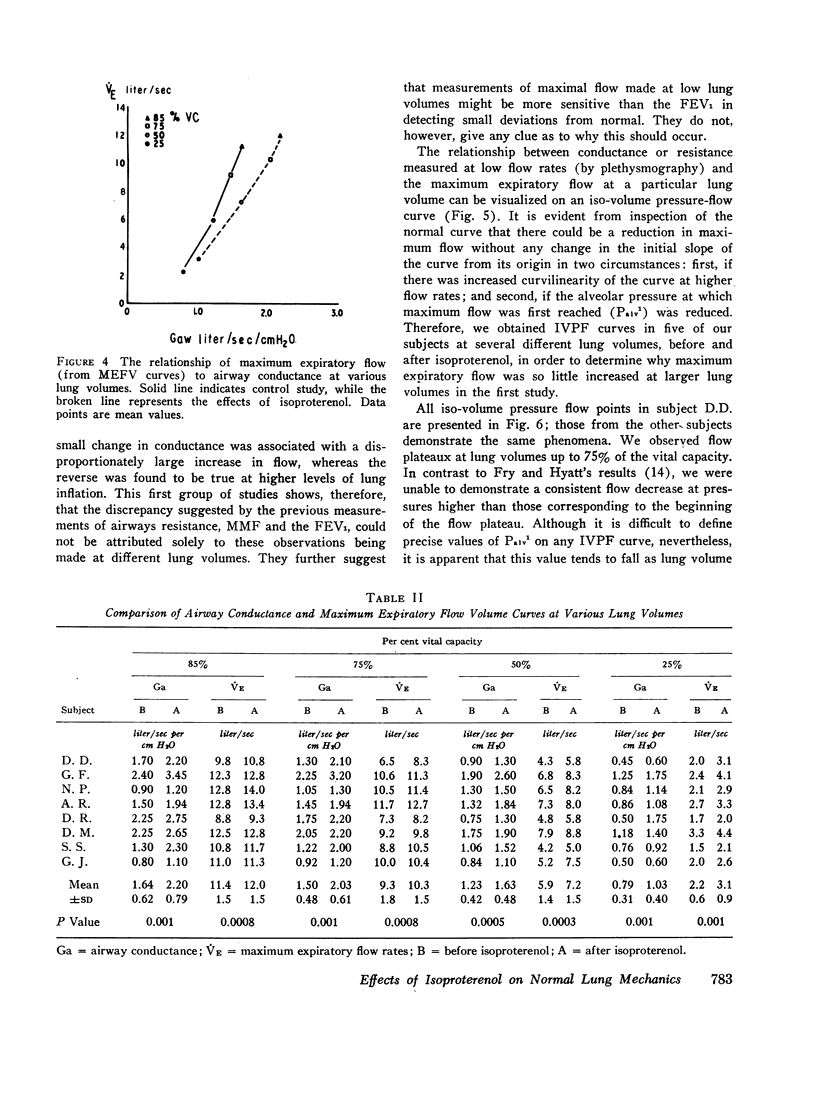
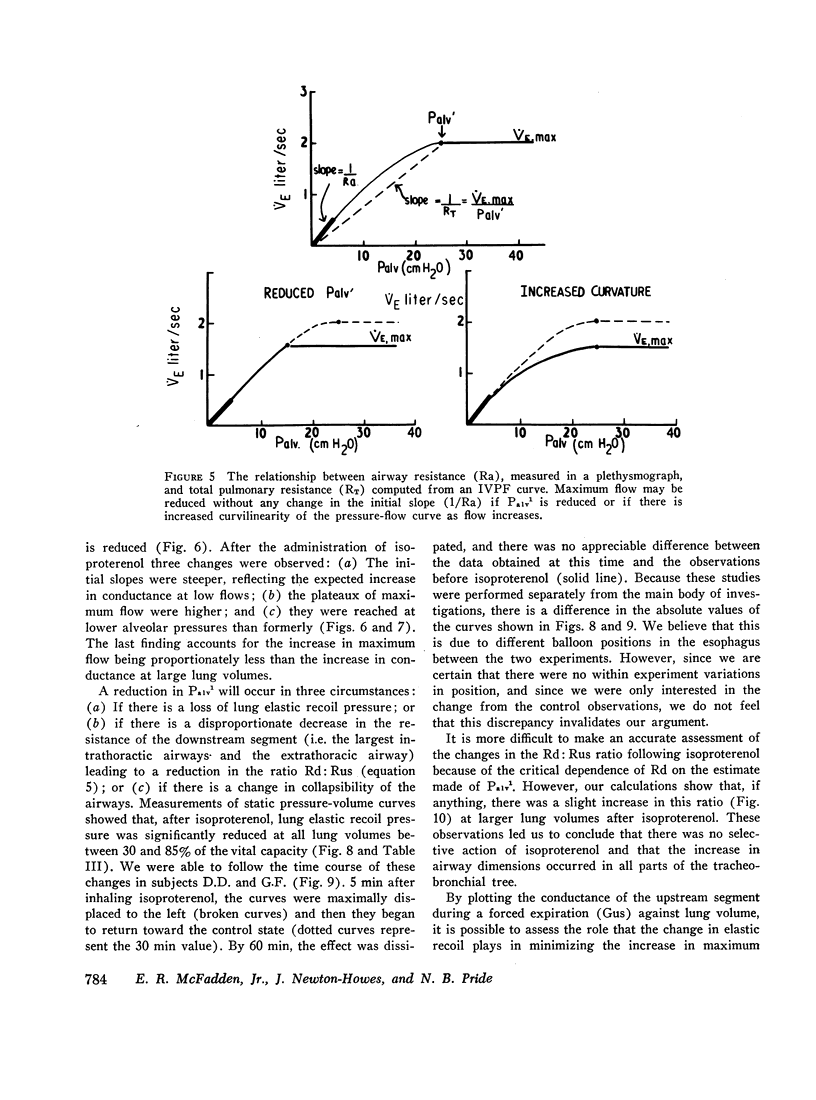
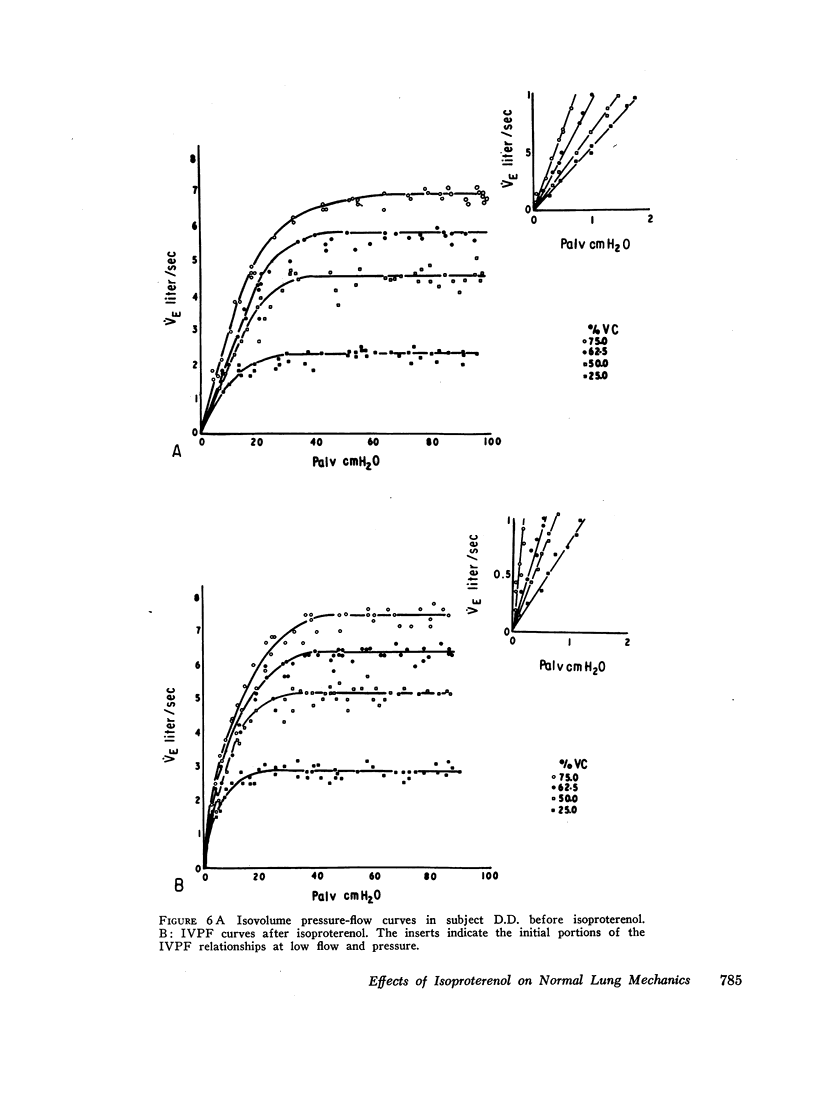
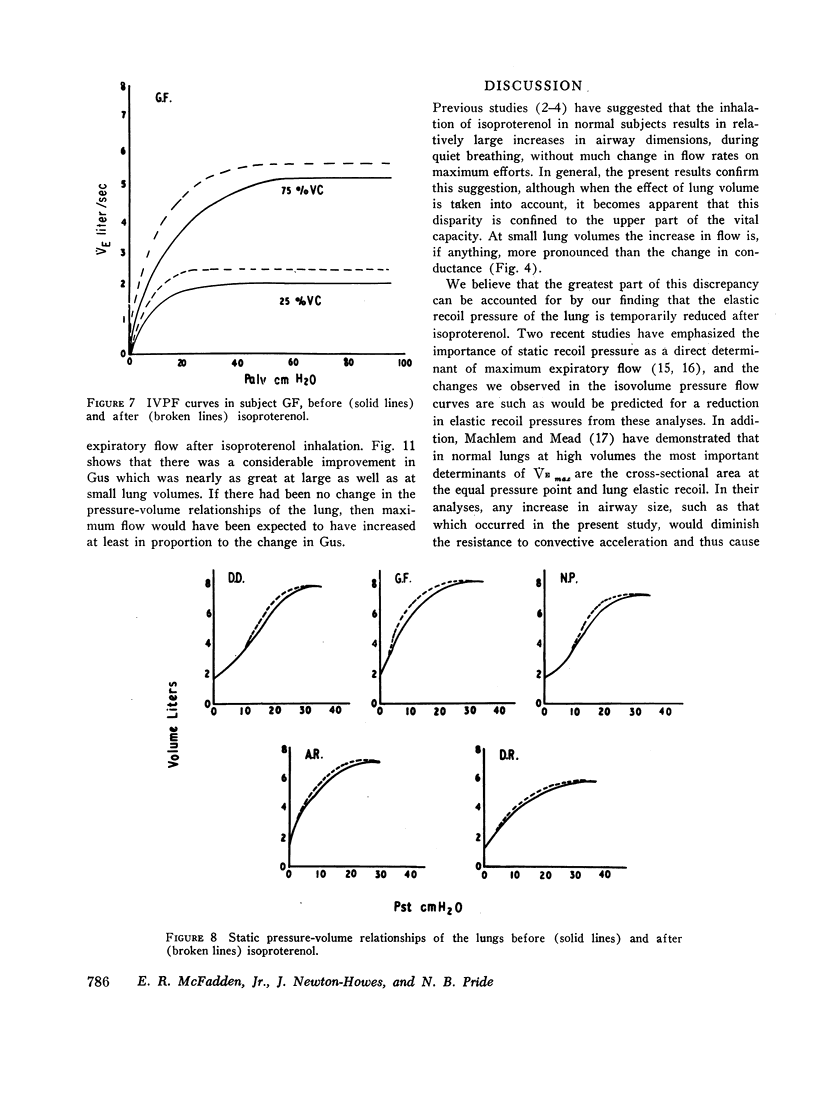
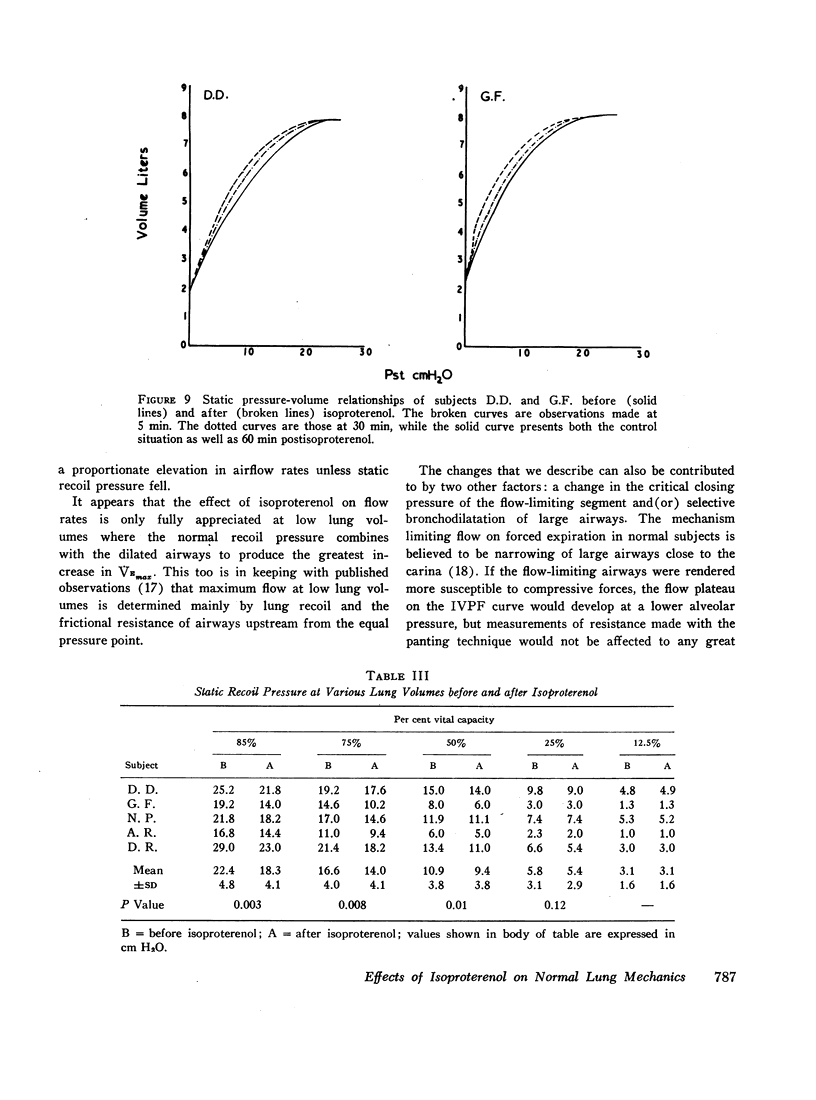
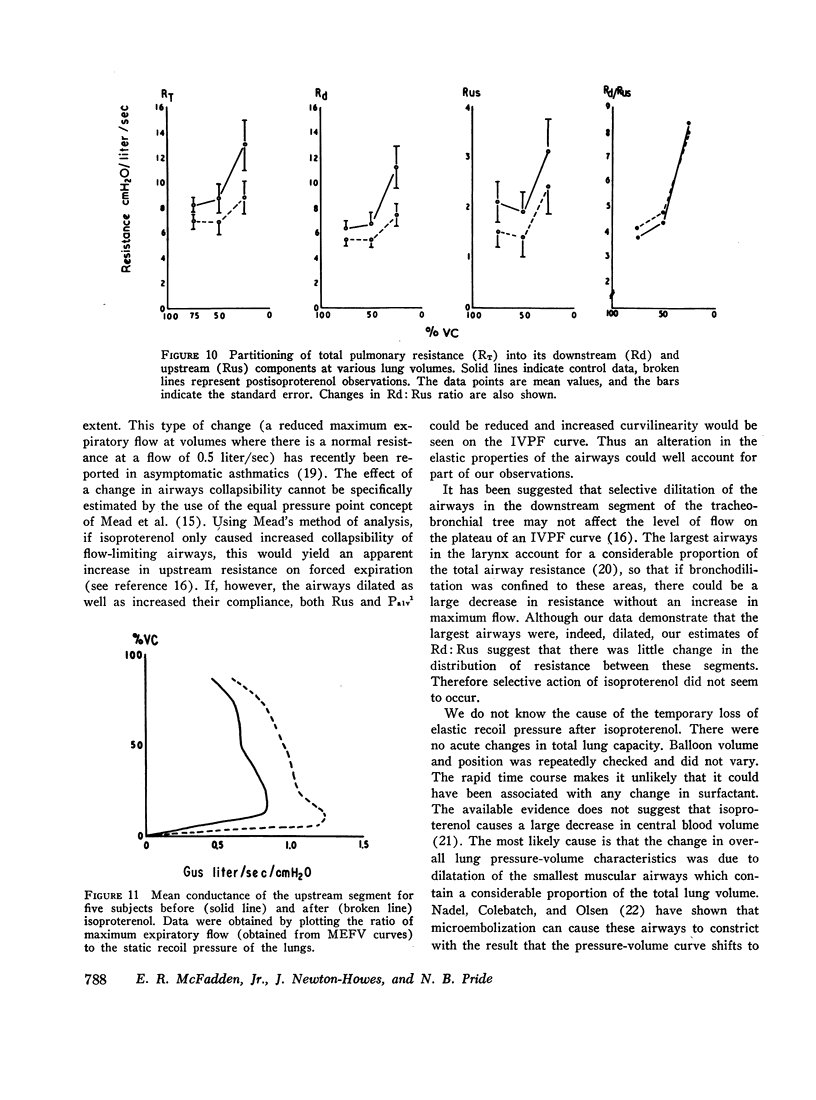
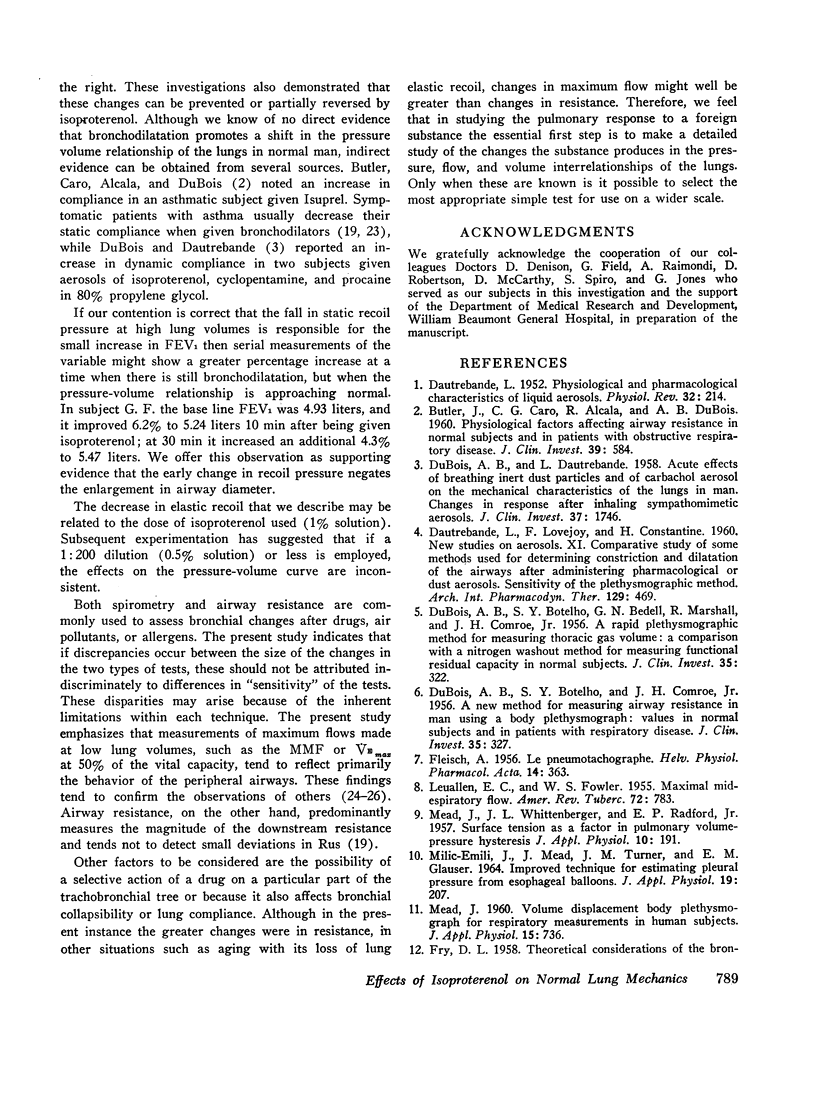
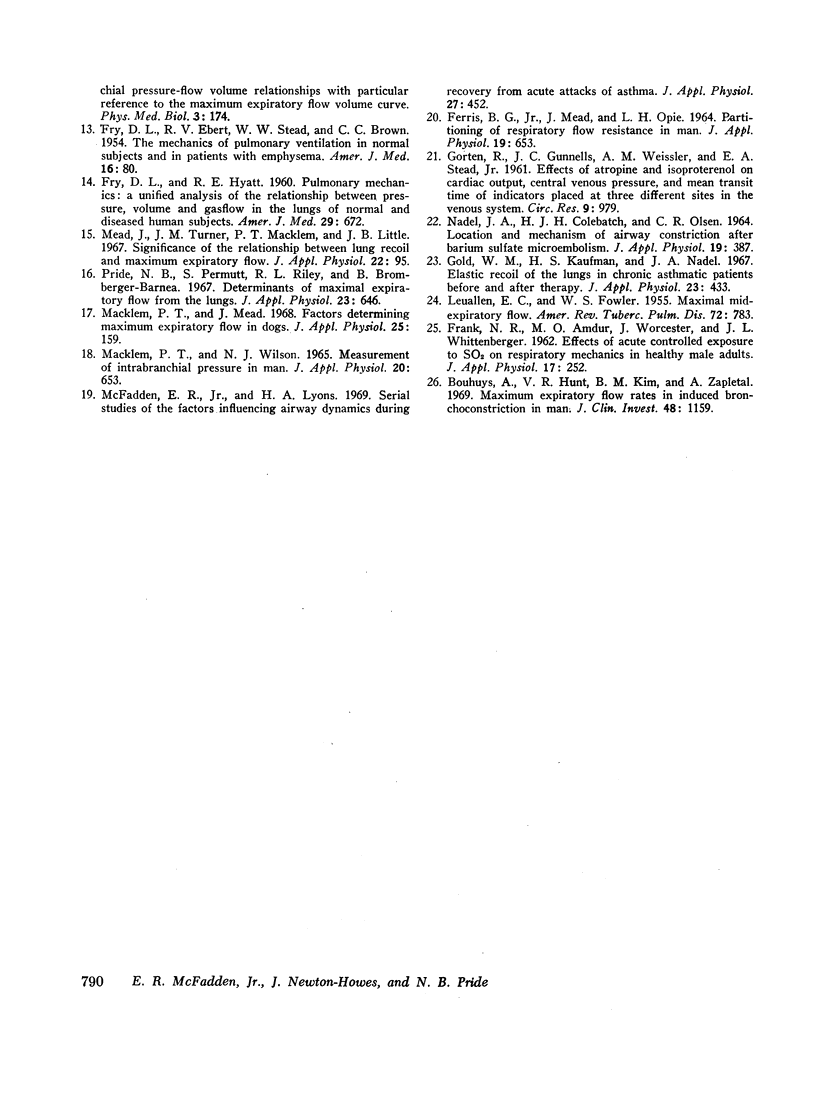
Selected References
These references are in PubMed. This may not be the complete list of references from this article.
- BUTLER J., CARO C. G., ALCALA R., DUBOIS A. B. Physiological factors affecting airway resistance in normal subjects and in patients with obstructive respiratory disease. J Clin Invest. 1960 Apr;39:584–591. doi: 10.1172/JCI104071. [DOI] [PMC free article] [PubMed] [Google Scholar]
- Bouhuys A., Hunt V. R., Kim B. M., Zapletal A. Maximum expiratory flow rates in induced bronchoconstriction in man. J Clin Invest. 1969 Jun;48(6):1159–1168. doi: 10.1172/JCI106073. [DOI] [PMC free article] [PubMed] [Google Scholar]
- DAUTREBANDE L. Physiological and pharmacological characteristics of liquid aerosols. Physiol Rev. 1952 Apr;32(2):214–275. doi: 10.1152/physrev.1952.32.2.214. [DOI] [PubMed] [Google Scholar]
- DUBOIS A. B., BOTELHO S. Y., BEDELL G. N., MARSHALL R., COMROE J. H., Jr A rapid plethysmographic method for measuring thoracic gas volume: a comparison with a nitrogen washout method for measuring functional residual capacity in normal subjects. J Clin Invest. 1956 Mar;35(3):322–326. doi: 10.1172/JCI103281. [DOI] [PMC free article] [PubMed] [Google Scholar]
- DUBOIS A. B., BOTELHO S. Y., COMROE J. H., Jr A new method for measuring airway resistance in man using a body plethysmograph: values in normal subjects and in patients with respiratory disease. J Clin Invest. 1956 Mar;35(3):327–335. doi: 10.1172/JCI103282. [DOI] [PMC free article] [PubMed] [Google Scholar]
- DUBOIS A. B., DAUTREBANDE L. Acute effects of breathing inert dust particles and of carbachol aerosol on the mechanical characteristics of the lungs in man; changes in response after inhaling sympathomimetic aerosols. J Clin Invest. 1958 Dec;37(12):1746–1755. doi: 10.1172/JCI103767. [DOI] [PMC free article] [PubMed] [Google Scholar]
- FERRIS B. G., Jr, MEAD J., OPIE L. H. PARTITIONING OF RESPIRATORY FLOW RESISTANCE IN MAN. J Appl Physiol. 1964 Jul;19:653–658. doi: 10.1152/jappl.1964.19.4.653. [DOI] [PubMed] [Google Scholar]
- FLEISCH A. Le Pneumotachographe. Helv Physiol Pharmacol Acta. 1956;14(3):363–368. [PubMed] [Google Scholar]
- FRANK N. R., AMDUR M. O., WORCESTER J., WHITTENBERGER J. L. Effects of acute controlled exposure to SO2 on respiratory mechanics in healthy male adults. J Appl Physiol. 1962 Mar;17:252–258. doi: 10.1152/jappl.1962.17.2.252. [DOI] [PubMed] [Google Scholar]
- FRY D. L., EBERT R. V., STEAD W. W., BROWN C. C. The mechanics of pulmonary ventilation in normal subjects and in patients with emphysema. Am J Med. 1954 Jan;16(1):80–97. doi: 10.1016/0002-9343(54)90325-3. [DOI] [PubMed] [Google Scholar]
- FRY D. L., HYATT R. E. Pulmonary mechanics. A unified analysis of the relationship between pressure, volume and gasflow in the lungs of normal and diseased human subjects. Am J Med. 1960 Oct;29:672–689. doi: 10.1016/0002-9343(60)90100-5. [DOI] [PubMed] [Google Scholar]
- FRY D. L. Theoretical considerations of the bronchial pressure-flow-volume relationships with particular reference to the maximum expiratory flow volume curve. Phys Med Biol. 1958 Oct;3(2):174–194. doi: 10.1088/0031-9155/3/2/307. [DOI] [PubMed] [Google Scholar]
- GORTEN R., GUNNELLS J. C., WEISSLER A. M., STEAD E. A., Jr Effects of atropine and isoproterenol on cardiac output, central venous pressure, and mean transit time of indicators placed at three different sites in the venous system. Circ Res. 1961 Sep;9:979–983. doi: 10.1161/01.res.9.5.979. [DOI] [PubMed] [Google Scholar]
- Gold W. M., Kaufman H. S., Nadel J. A. Elastic recoil of the lungs in chronic asthmatic patients before and after therapy. J Appl Physiol. 1967 Oct;23(4):433–438. doi: 10.1152/jappl.1967.23.4.433. [DOI] [PubMed] [Google Scholar]
- LEUALLEN E. C., FOWLER W. S. Maximal midexpiratory flow. Am Rev Tuberc. 1955 Dec;72(6):783–800. doi: 10.1164/artpd.1955.72.6.783. [DOI] [PubMed] [Google Scholar]
- LEUALLEN E. C., FOWLER W. S. Maximal midexpiratory flow. Am Rev Tuberc. 1955 Dec;72(6):783–800. doi: 10.1164/artpd.1955.72.6.783. [DOI] [PubMed] [Google Scholar]
- MEAD J., WHITTENBERGER J. L., RADFORD E. P., Jr Surface tension as a factor in pulmonary volume-pressure hysteresis. J Appl Physiol. 1957 Mar;10(2):191–196. doi: 10.1152/jappl.1957.10.2.191. [DOI] [PubMed] [Google Scholar]
- MILIC-EMILI J., MEAD J., TURNER J. M., GLAUSER E. M. IMPROVED TECHNIQUE FOR ESTIMATING PLEURAL PRESSURE FROM ESOPHAGEAL BALLOONS. J Appl Physiol. 1964 Mar;19:207–211. doi: 10.1152/jappl.1964.19.2.207. [DOI] [PubMed] [Google Scholar]
- Macklem P. T., Mead J. Factors determining maximum expiratory flow in dogs. J Appl Physiol. 1968 Aug;25(2):159–169. doi: 10.1152/jappl.1968.25.2.159. [DOI] [PubMed] [Google Scholar]
- Macklem P. T., Wilson N. J. Measurement of intrabronchial pressure in man. J Appl Physiol. 1965 Jul;20(4):653–663. doi: 10.1152/jappl.1965.20.4.653. [DOI] [PubMed] [Google Scholar]
- McFadden E. R., Jr, Lyons H. A. Serial studies of factors influencing airway dynamics during recovery from acute asthma attacks. J Appl Physiol. 1969 Oct;27(4):452–459. doi: 10.1152/jappl.1969.27.4.452. [DOI] [PubMed] [Google Scholar]
- Mead J., Turner J. M., Macklem P. T., Little J. B. Significance of the relationship between lung recoil and maximum expiratory flow. J Appl Physiol. 1967 Jan;22(1):95–108. doi: 10.1152/jappl.1967.22.1.95. [DOI] [PubMed] [Google Scholar]
- NADEL J. A., COLEBATCH J. H., OLSEN C. R. LOCATION AND MECHANISM OF AIRWAY CONSTRICTION AFTER BARIUM SULFATE MICROEMBOLISM. J Appl Physiol. 1964 May;19:387–394. doi: 10.1152/jappl.1964.19.3.387. [DOI] [PubMed] [Google Scholar]
- Pride N. B., Permutt S., Riley R. L., Bromberger-Barnea B. Determinants of maximal expiratory flow from the lungs. J Appl Physiol. 1967 Nov;23(5):646–662. doi: 10.1152/jappl.1967.23.5.646. [DOI] [PubMed] [Google Scholar]


